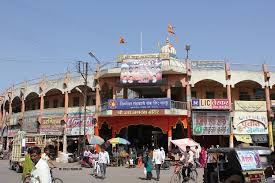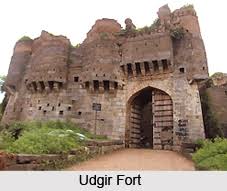Trans-tert-Butyl-2-(4-methoxyphenyl)-cyclopropylcarbamate
DPPA (11 mls, 50.9 mmol) was added to a stirred mixture of the product from Preparation 78 (8.9 g, 46.3 mmol), triethylamine (10.1 mls, 72.7 mmol) and tert-BuOH (75 mls). The mixture was heated at 90° C. for 43 h. When cool, the tert-BuOH was removed by evaporation and the resulting oily residue treated with saturated K2CO3 (120 ml) and then extracted with EtOAc (2×100 mls). The combined organic extracts were then evaporated under reduced pressure to give a brown solid which was purified by column chromatography using DCM:MeOH (98:2) as eluant to provide the title product (5.8 g, 148%);
1HNMR (400 MHz, CDCl3) δ: 1.07-1.14 (m, 2H), 1.44 (s, 9H), 1.93-2.06 (m, 1H), 2.62-2.71 (m, 1H), 3.80 (s, 3H), 4.72-4.88 (m, 1H), 6.80 (d, 2H), 7.08 (d, 2H).
LATUR, MAHARASHTRA, INDIA
http://en.wikipedia.org/wiki/Latur





his Is The Famous 'Ganj-Golai' As The Central Place Of The Latur City. There Are 16 Roads Connecting To This Place And Seperate Markets i.e. Jewellers ...

लातूर जिल्हयातील चित्र संग्रह

LATUR AIRPORT
 LATUR AIRPORT
LATUR AIRPORT




2012 Navratri Mahotsav in Latur

SOS Children's Village Latur


Latur, India: Carnival Resort


Ausa Near Latur

Chakur near Latur

Vilasrao Deshmukh's ancestral home at Babhalgaon village in Latur. Machindra Amle




UDGIR: Udgir is one of the most important towns of Latur district. Udgir has a great historical significance. It has witnessed the war between the Marathas ...


 The city of Latur is located in India's welathiest state, Maharashtra. Together with many of the surrounding villages, Latur was all but destroyed in the
The city of Latur is located in India's welathiest state, Maharashtra. Together with many of the surrounding villages, Latur was all but destroyed in the
LATUR, MAHARASHTRA, INDIA
http://en.wikipedia.org/wiki/Latur
| Latur लातूर Lattalur, Ratnapur | |
|---|---|
| City | |
| Location in Maharashtra, India | |
| Coordinates: 18.40°N 76.56°ECoordinates: 18.40°N 76.56°E | |
| Country | |
| State | Maharashtra |
| Region | Aurangabad Division |
| District | Latur |
| Settled | Possibly 7th century AD |
| Government | |
| • Body | Latur Municipal Corporation |
| • Mayor | Akhtar Shaikh |
| Area[1] | |
| • Total | 117.78 km2(45.48 sq mi) |
| Area rank | 89 |
| Elevation | 515 m (1,690 ft) |
| Population (2011) | |
| • Total | 382,754 |
| • Rank | 89th |
| • Density | 3,200/km2(8,400/sq mi) |
| Demonym | Laturkar |
| Languages | |
| • Official | Marathi |
| Time zone | IST (UTC+5:30) |
| PIN |
|
| Telephone code | 91-2382 |
| Vehicle registration | MH-24 |
| Sex ratio | 923.54 ♀/1000 ♂ |
| Literacy | 89.67 |
| Distance from Mumbai | 497 kilometres (309 mi) E (land) |
| Distance fromHyderabad | 337 kilometres (209 mi) NW (land) |
| Distance fromAurangabad, Maharashtra | 294 kilometres (183 mi) SE (land) |
| Climate | BSh (Köppen) |
| Precipitation | 666 millimetres (26.2 in) |
| Avg. summer temperature | 41 °C (106 °F) |
| Avg. winter temperature | 13 °C (55 °F) |
| http://www.citypopulation.de/world/Agglomerations.html | |
his Is The Famous 'Ganj-Golai' As The Central Place Of The Latur City. There Are 16 Roads Connecting To This Place And Seperate Markets i.e. Jewellers ...
लातूर जिल्हयातील चित्र संग्रह
LATUR AIRPORT

2012 Navratri Mahotsav in Latur
SOS Children's Village Latur
Latur, India: Carnival Resort
Ausa Near Latur
Chakur near Latur
Vilasrao Deshmukh's ancestral home at Babhalgaon village in Latur. Machindra Amle

UDGIR: Udgir is one of the most important towns of Latur district. Udgir has a great historical significance. It has witnessed the war between the Marathas ...

